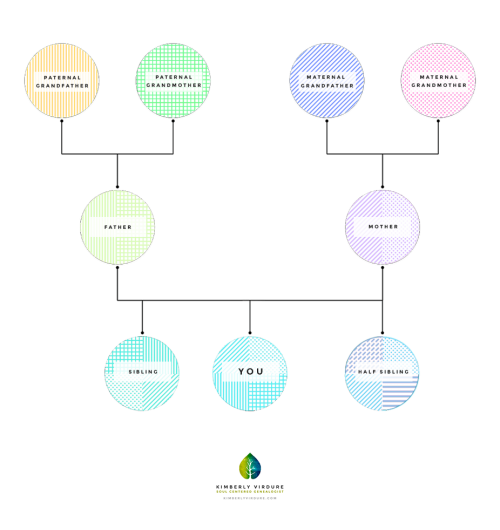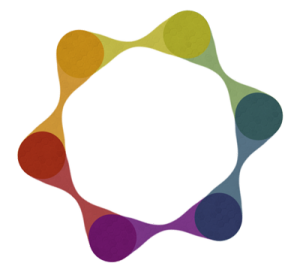DNA evidence is essential if you truly want to know the people who’ve come together throughout time to create you. Knowing how genealogical DNA tests work and how to interpret data they provide opens you to infinite facets of the biological story that’s led to your Earthly existence.
You’ll find this article helpful if you’re:
- considering submitting your DNA to a testing company,
- just beginning the journey into genealogical DNA research (genetic genealogy), or
- you just want a basic idea of what you can discover from your DNA.
Your DNA Reveals A Story That Transcends Ethnicity
DNA testing companies provide estimates of where your ancestors lived, but this is just part of your biological history. While the Human experience is heavily influenced by ethnicity and geography, it’s not completely defined by it.
Your Ancestors’ life experiences are literally imprinted in your cells.
Like our genomes, we’re so much the same, yet we have distinctly unique experiences of being human. Your ancestors may have lived in Asia, the Americas, Africa, or Europe, yet each one of them had their own personality, talents, fears, and affinities. No two lifetimes are experienced the same.
Genetic Genealogy supports your personal evolution.
The effects of your ancestor’s intellectual, physical, and energetic (aka spiritual) responses to their personal experiences of life live on as the genetic imprint you’re evolving. As you discover your ancestors through DNA and their life stories through genealogical research, you become more deeply acquainted with genetic and emotional inheritances (family dynamics) you’re presently evolving.
What DNA Tests Reveal About Your Biological Ties
What do you want to know about your ancestors?
YDNA Tests

YDNA tests trace paternal ancestry by evaluating the Y-chromosome which is only found in males. The Y chromosome is passed from father to son with little change over time. This enables the ability to trace your father’s paternal line back thousands of years. YDNA tests can only be taken by males.
MtDNA Tests

MtDNA (Mitochondrial DNA) tests trace maternal ancestry by looking at the X-chromosome. Mitochondrial DNA is passed from mother to both male and female offspring. As with YDNA, MtDNA changes slowly over time and can trace your direct maternal line back thousand of years. MtDNA tests can be taken by females and males.
Autosomal DNA Tests

Autosomal DNA tests trace direct ancestors on both maternal and paternal lines through the examination of chromosomes 1 – 22. Both males and females can take this test. Popular genetic genealogy DNA testing companies such as My Heritage, 23andMe, Ancestry, and FamilyTreeDNA use autosomal DNA tests.
Your Human History in DNA, Chromosomes, and Genes
Here are a few definitions of foundational terms you need to understand to make the most of your DNA discoveries.
Genome
A genome is the entirety of all your inherited genetic material. A complete copy of your genome is present in each cell that has a nucleus. The human genome is made of about 3 billion bases of DNA which are 99.999% the same for each of us. The .001% variation in our DNA makes each of us original.
Deoxyribonucleic acid (DNA)
DNA is a chemical strand found in each of our cells. Each DNA strand carries genetic information that is passed from parent to offspring for generations.
Chromosomes
Chromosomes are thread-like structures made of protein and a single DNA molecule that reside in the nucleus of each of our cells. Human chromosomes are arranged in 23 pairs. Each pair has 1 chromosome inherited from your mother and 1 from your father.
Genes
Our genes provide biological instructions for cellular activities. Though they only make up about 3% of the DNA molecule in each cell, your genes are the unique combination of biological inheritances that make you, You.
How Your DNA Matches are Analyzed
You’ll see your DNA matches in CMs and SNPs with most genetic genealogy testing services.
CentiMorgans
Though we all share common strands of DNA we share longer segments of DNA with relatives born within a more recent genealogical timeframe. DNA tests examine the difference between chromosome positions on a DNA segment. Shared DNA segments between you and a DNA match are defined as CentiMorgans (cMs).
SNPs
A Single-Nucleotide Polymorphism (SNP) or “snip” is a genetic variation in a DNA sequence. SNPs are inherited from our direct ancestors and shared by our relatives, so they’re examined to trace our genetic genealogy.
Genetic inheritance is (seemingly) random.
It’s important to understand how your ancestor’s DNA has been passed to you when analyzing DNA test results.
Your DNA results don’t reveal 100% of each of your parent’s DNA. You inherited 50% of your DNA from your Mother, and 50% from your Father.

Your siblings inherited their own unique combination of your parent’s DNA (always 50% from each parent).

Why DNA tests don’t reveal every relative.
Our individual genetic uniqueness is one reason why more removed biological relatives who don’t appear as DNA matches to you, may match a parent or sibling.
As an example, you may have inherited matching DNA segments from your maternal Grandfather that your sibling didn’t. Consequently, analysis of your DNA will match you to a few of your Grandfather’s relatives that your sibling may not – though you’re both biological relatives of all of Grandfather’s biological lines.

DNA matches of your relatives provide ancestral clues your DNA alone cannot. As you analyze your connections to your DNA matches, remember:
- Your parents have DNA markers from your grandparents that you didn’t inherit (because you only carry 50% of each parent’s DNA).
- Your grandparents, their children (your aunts and uncles), and your grandparents’ siblings (your great aunts and uncles) carry DNA markers from your great grandparents that neither you or your parents inherited.
- Cousin DNA is essential to discovering your direct lines of ancestry (all your grandparents). If you don’t have DNA tests for your immediate family, your cousins (direct descendants of common grandparents), carry DNA markers inherited from grandparents that you may or may not carry.
I wrote an article that clarifies exactly how you’re related to your relatives, and the meaning of the term ‘removed’ —> here.
Probabilities of Detectable Matches with DNA Tests
The likelihood of sharing a DNA match with a biological relative varies due to the laws of Nature. Your shared DNA with parents, siblings, and close aunts, uncles, grandparents, and cousins is detectable. The further removed a relative is, the lower the probability that a DNA match will be detected, though you’re biologically related.
Mainstream genetic genealogy testing companies each explore a small segment of DNA with their own methods of analyzing data. The likelihood of a testing company detecting shared DNA between you and another relative who’s also tested varies with each service, these are loose guidelines:
|
Relative |
Probability of Detected DNA |
Average Number of Detectable Matches (out of 10) |
|
Children, Parents, Siblings, Grandparents, Great Grandparents, Nieces, Nephews, Aunts, Uncles |
100% |
10 |
|
First Cousins |
100% |
10 |
|
Second Cousins |
100% |
10 |
|
Third Cousins |
90% |
9 |
|
Fourth Cousins |
50% – 70% |
5 – 7 |
|
Fifth Cousins |
10% – 30% |
1 – 3 |
|
Sixth Cousins |
2% – 10% |
2 – 10 |
|
Seventh Cousins |
1% – 3% |
< 1 |
For every 100 4th cousins who’ve tested with the same company as you, just 50 – 70 of them will show up as your DNA match, even though you’re related. This is why examining the DNA matches of your DNA matches is an important step toward discovering the grandparents you have in common.
DNA Matches of Your DNA Matches Also Reveal Your Ancestors
You have genetic matches whose DNA contains matching segments with relatives you don’t match (see above).
When close DNA matches don’t provide genealogical documentation (family trees), examining genealogical documentation tied to DNA matches of your matches will shed light on how you’re related – provided you invest time in organized genealogical research to validate the connections (genetic genealogy).
Do you know how many grandparents are being revealed by your DNA matches?
Autosomal DNA tests offered on popular genetic genealogy websites reveal DNA inherited from as far back as our 5th grandparents. We each have 128 5th great grandparents!
|
Generation |
Ancestors |
Total Ancestors Per Generation |
Cumulative Ancestors |
|
1 |
You |
||
|
2 |
Parents |
2 |
2 |
|
3 |
Grandparents |
4 |
6 |
|
4 |
Great Grandparents |
8 |
14 |
|
5 |
2nd Great Grandparents |
16 |
30 |
|
6 |
3rd Great Grandparents |
32 |
62 |
|
7 |
4th Great Grandparents |
64 |
126 |
|
8 |
5th Great Grandparents |
128 |
254 |
Though most of us don’t actually have 128 5th great grandparents (or a total of 254 direct ancestors 7 generations back) due to a phenomenon called pedigree collapse, this chart gives you an idea of the vast number of individual human lives you’re biologically bonded to. Your DNA matches and their matches provide the clues.
You can read more about genealogical research of your grandparents and learn the meaning of pedigree collapse (you *really* need to understand this before you study your DNA connections) here –> Why You’ll Never Know How Many Grandparents You Have.
DNA Evidence Needs Genealogical Research to Come to Life
When close DNA matches don’t provide genealogical documentation (family trees), examining genealogical documentation tied to DNA matches of your matches will shed light on how you’re related – provided you invest time in your own genealogical research to validate the connections (genetic genealogy). Always remember this important fact: the majority of family trees published online are not accurate. Estimated match relationships provided by DNA testing companies are clues, but they are not absolute fact. You have to validate your connection with DNA matches with your own (well-sourced) evidentially-based genealogical research.
If DNA matches without family trees seem to be posing obstacles in your research, read this article for tips on how to leverage your treeless DNA mystery matches to open new discoveries on your genetic genealogical journey.
There’s much more to explore and learn about with genetics
As a soul-centered genealogist, I leverage DNA data to identify and discover the lives of our most recent ancestors (5-8 generations back or about 250 years). Your DNA reveals much more about your ancestry, health, and our collective human history. If you’d like to expand your knowledge about genetics:
- Genetics Home Reference from the National Library of Medicine
- Beginners’ guides to genetic genealogy from the International Society of Genetic Genealogy Wiki

Soul Centered
DNA Discoveries
Let’s discover your people!
If you’ve received your DNA test results and need guidance on figuring out who and what they’re revealing to you, let’s meet (by phone or video) to discuss ways I can help you discover and document your kinship with Humanity.





